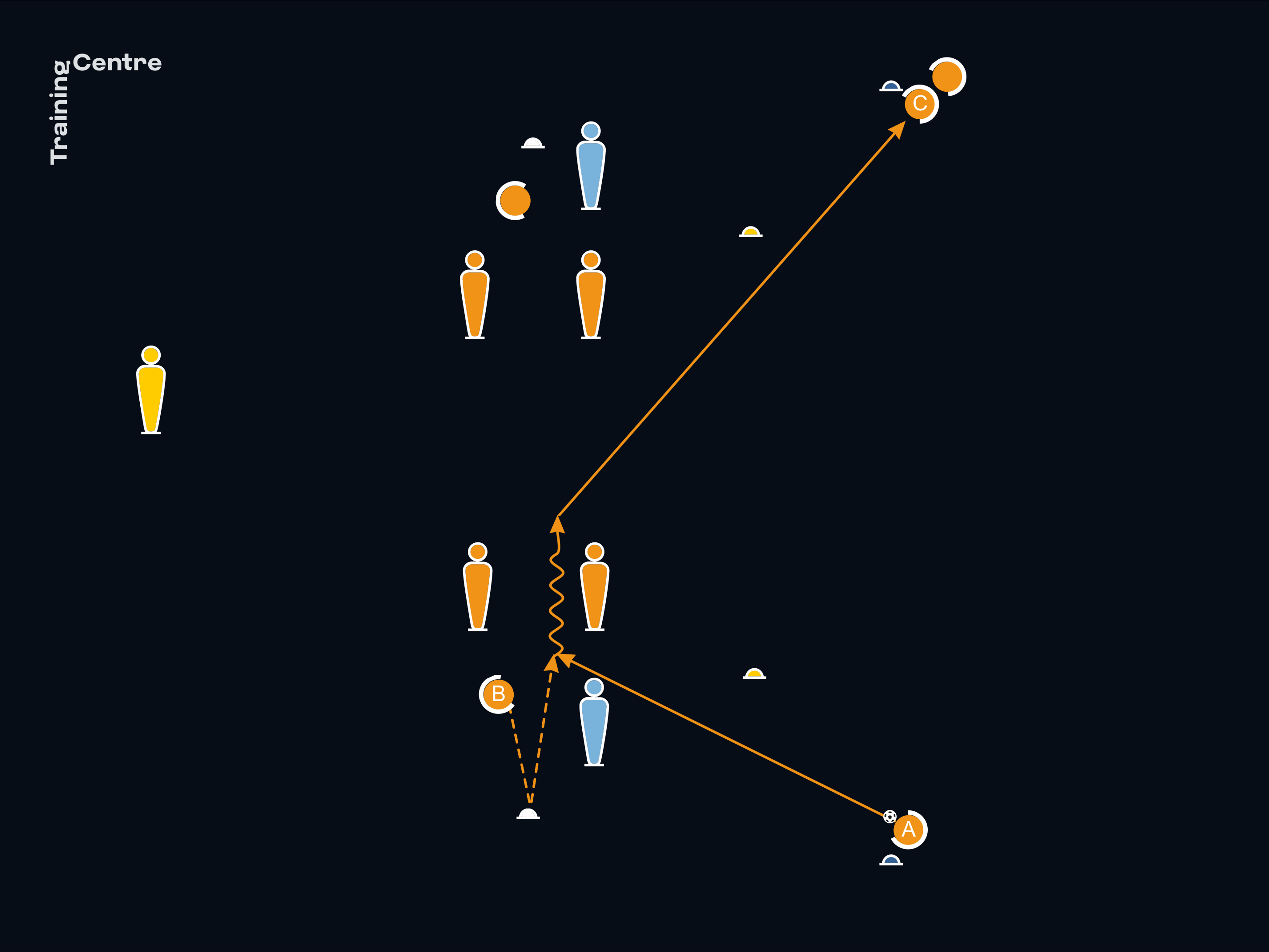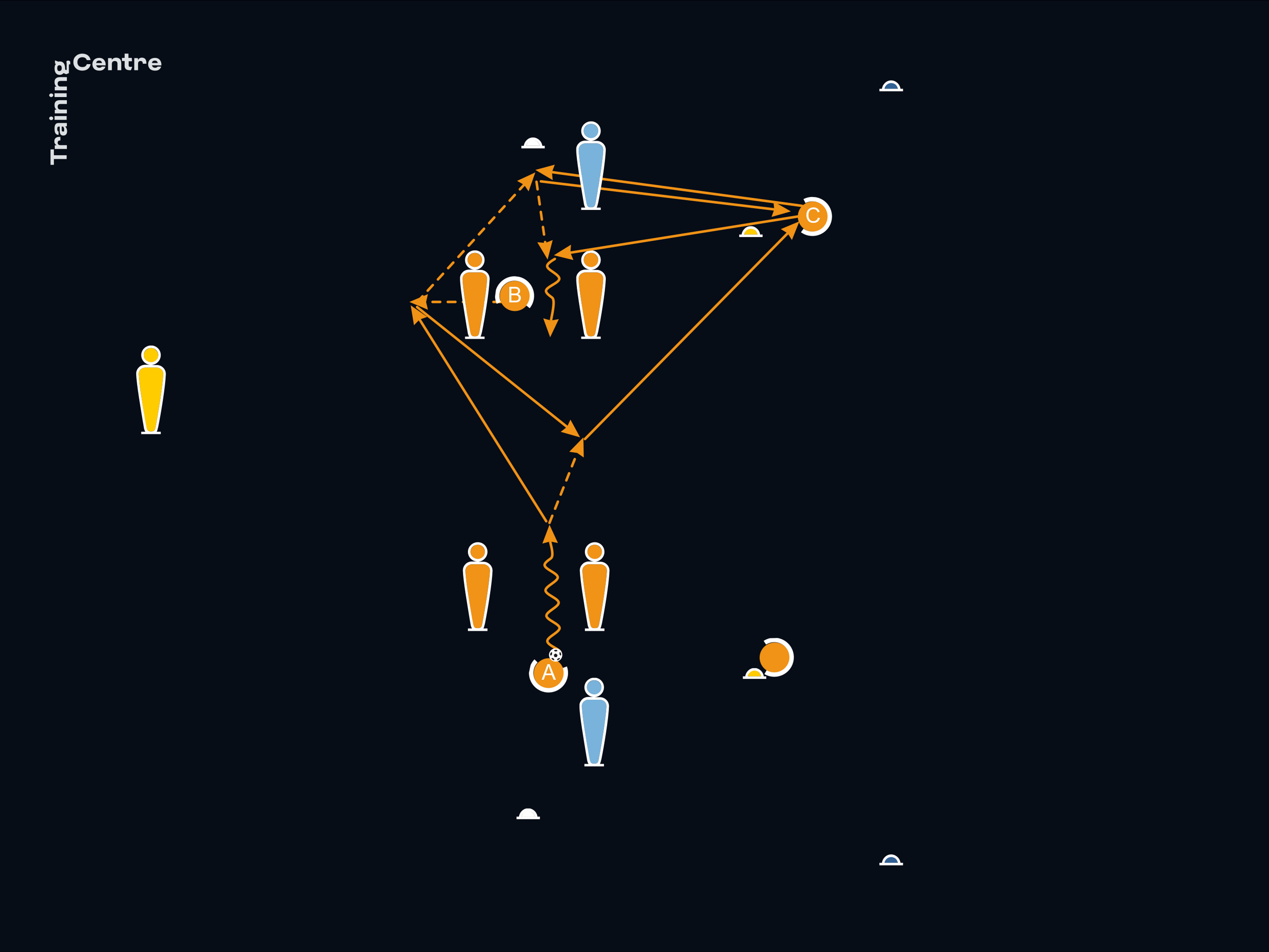The drills place greater emphasis on the individual player and specifically concentrate on playing forward quickly in various receiving scenarios.
Set-up for all drills

Organisation
- Mark out a 30-metre line using blue cones (a).
- Move 7.5 metres inwards from the blue cone that marks the beginning of the 30-metre line (b) and 1 metre towards the centre and place a white cone (c).
- Move 4 metres towards the centre from the white cone and set up a red mannequin gate (d).
- Move 2 metres towards the outside of the grid from the red mannequin that is closest to (a) and place a blue mannequin (e).
- Move 5 metres from the centre of the red/blue mannequin gate towards (a) and place a yellow cone (f).
- Place a second red mannequin gate 15 metres from the first one (g) and mirror the same set-up there.
- Complete the set-up by placing a yellow mannequin 6 metres out from the middle of the grid (h) in the opposition direction to (a).
- If no mannequins are available, cones/discs may be used instead.
Drill duration
- 5-6 players: 3 minutes after a period in which players are given the time to familiarise themselves with the scenario.
Approximate workload intensity
- 5-6 players (optimum number): medium intensity.
Coaching points that apply to all drills
- Allow players 30 seconds to find their tempo and familiarise themselves with the scenario, before gradually raising the intensity demands.
- Devote a period of time (minimum of 1 minute) during each drill to intensity, technical skills and the development of awareness habits.
- Encourage players to move quickly between positions.
This set-up can be adapted to involve a full squad comprising 20 players or more. Where this is the case, up to 4 circuits are required, with 4 balls and 5 to 7 players involved in each circuit.
Drill 1: quick feet, technical coordination to turn and play forward and accelerate away

-
A dribbles through the starting mannequin gate, before playing an angled, vertical pass to B, who is positioned wide of the mannequin gate located at the opposite end of the grid.
-
B moves from the middle of the mannequin gate to take up a position wide of it in readiness to receive the ball on the half-turn, before carrying it and playing a short pass between the white cone and the blue mannequin to C, who is situated in the diagonal corner.
-
C plays a return pass into B's path.
-
B carries the ball through the red mannequin gate, before playing an angled vertical pass to start the next sequence at the opposite end.
-
A moves to C.
-
B moves to D.
-
C moves to B.
-
Place the emphasis on the quick feet and technical coordination required to turn and play forward at speed and turn and accelerate forward, all whilst keeping the ball under close control.
-
Players should play with their heads up and scan the area they are receiving the pass from and the intended destination of their own pass.
-
This drill promotes technical balance as it requires players to use their left and right feet in equal measure.
-
When turning forward to play the short diagonal pass to the right to C, B should allow the ball to run across their body to their right foot and play a right-footed pass.
-
B should try to meet the return pass early with their right foot and accelerate through the red mannequin gate, before playing a vertical, right-footed pass to D.
-
When the sequence begins at the opposite end and B turns to play the ball to the left, both passes should be left-footed.
-
To reinforce good habits, before receiving the vertical pass, B should scan towards C. Before receiving the ball back from C, B should scan up the pitch to the intended destination of their vertical pass.
Drill 2: countermovement to create space and meeting the ball on the move at speed

-
A plays a short diagonal pass from the corner starting position into the space between the red and blue mannequins to B.
-
B makes a countermovement from in line with the blue mannequin to the white cone, before moving forward to receive the pass and accelerating through the gate with their first touch and playing a diagonal pass to C at the opposite starting corner with their second.
-
C then starts the next sequence from that corner.
-
Every player follows their pass to ensure player rotation.
-
A moves to B.
-
B moves to C.
-
The major focus in this drill is on the quick feet required in the countermovement to engineer space, as well as meeting the ball on the move at speed, driving forward with the first touch and playing a pass with the second.
-
The timing and coordination between A's pass and B's movement is also crucial.
-
This drill promotes technical balance as it requires players to use their left and right feet in equal measure.
-
A should play the left-to-right pass to B using their left foot. The opposite applies when the pass is played from the right to the left.
-
When receiving the left-to-right pass from A, B should meet the ball with their right foot and accelerate through the red mannequin gate, before playing the diagonal pass to the left, which should also be played with their right foot. The opposite applies when B receives the right-to-left pass from A.
Drill 3: quick feet, first-time pass-and-move combinations in tight spaces

-
A carries the ball through the starting red mannequin gate, before playing a forward diagonal pass to B, who is situated wide of the other red mannequin gate.
-
A then moves diagonally forward to receive B's return pass, before playing a short diagonal pass to C, who is located at the starting position at the opposite end of the circuit.
-
In the meantime, B advances past the blue mannequin to play a short one-two with C.
-
C plays the return pass to B into the space between the red and blue mannequins.
-
B then drives through the red mannequin gate to start the next sequence at the other end of the circuit.
-
A moves to C.
-
C moves to B.
-
B starts the next sequence and moves to A.
-
The major focus in this exercise is on the variation between left- and right-footed passing, with players challenged to use the most appropriate foot in an effort to increase the efficiency and tempo of the drill.
-
Amongst the key goals pursued in this exercise are fluency of movement and player technique in tight spaces, as well as coordination between a three-player unit.
-
This drill promotes technical balance as it requires players to use their left and right feet in equal measure.
Drill 4: give-and-go and playing the runner in behind

-
A begins the sequence from the corner starting position by playing a diagonal, forward pass ahead of the yellow mannequin and into B's path.
-
On receiving the ball, B plays a diagonal pass between the blue mannequin and the white cone to C, who is located in the opposite corner.
-
B then bursts forward to play a short diagonal give-and-go with C, who makes a short curved run behind the yellow cone to receive B's pass.
-
C starts the next sequence.
-
Every player follows their pass to ensure player rotation.
-
A moves to B.
-
B moves to C.
-
The main emphasis in this exercise is on the speed and accuracy of the first-time passing between B and C to set up the diagonal pass to the player positioned at the yellow mannequin, as well as the timing of movement involved in C's run to meet B's pass.
-
This drill promotes technical balance as it requires players to use their left and right feet in equal measure.
-
A should play the left-to-right diagonal pass with their left foot. The opposite applies for the right-to-left diagonal pass, which A should play with their right foot.
-
While scanning to gain information about the position of the ball, B should make a short burst from behind the yellow mannequin to ensure that their run is well timed to meet A's pass.
-
When playing the right-to-left diagonal pass to C, B should try to play a right-footed pass. The same applies for the short return pass that picks out C, who has made a run from behind the yellow cone. The opposite applies to the left-to-right diagonal passing sequence, which should feature left-footed passes.
-
After playing the give-and-go with B, C should make a short forward dart to meet the return pass.





















